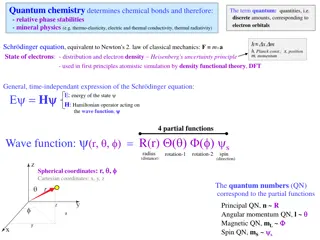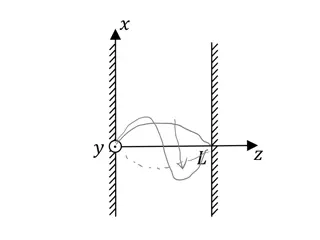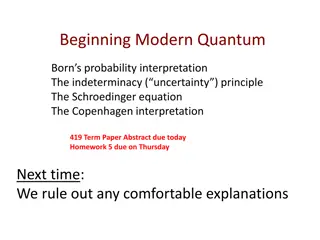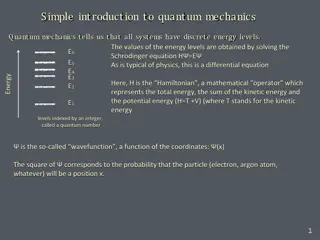Introduction to Statistical Mechanics and Quantum Mechanics
In statistical mechanics, quantum mechanics teaches us that all systems have discrete energy levels. By examining ensembles of atoms or molecules with different energy levels, we can understand probabilities, thermal equilibrium, and average energy using Boltzmann's postulate and the partition function.
Download Presentation

Please find below an Image/Link to download the presentation.
The content on the website is provided AS IS for your information and personal use only. It may not be sold, licensed, or shared on other websites without obtaining consent from the author. Download presentation by click this link. If you encounter any issues during the download, it is possible that the publisher has removed the file from their server.
E N D
Presentation Transcript
Simple introduction to statistical mechanics Quantum mechanics tells us that all systems have discrete energy levels. Let s say we have an ensemble (a large group) of atoms or molecules that can individually be in energy levels Ej. We ll use the index j to designate the allowed values of the energy. E6 E5 E4 E3 Energy Some of these levels may be degenerate. In other words we may have more than one quantum state that has the same energy. Let gj designate this degeneracy (gj= 1, 2, 3, .) E2 E1 levels indexed by an integer, called a quantum number Let N be the total number of atoms and Nj be the number of atoms with energy Ej. Obviously, if we sum Nj over all values of j, the result will be N The probability that the atoms will have energy Ej is just the number that have energy j divided by the total number: pj = Nj/N
Problem for you: show that . Thus we say the probabilities are normalized . Boltzmann postulated that when a system is in thermal equilbrium at temperature T, the number of atoms with energy Ej is proportional to an exponential of the energy . Here gj is the degeneracy of each level and k (sometimes designated kB) is Boltzmann s constant 1.38 10 23 J /K. If we use the equation on the previous page you can show (do it) that the Boltzmann probability that the atoms have energy Ej is Here q(T) is the partition function This partition function is the sum over all states of the weighted number of atth\ states occupied. At low temperature, under the assumption that the ground state is singly- degenerate, then the probability will be 1 for the ground state and zero otherwise. Why? Thus
As the temperature increases, the partition function increases. It is the sum over all the states of the number of states with energy Ej weighted by the Boltzmann exponential factor for that state. At high temperature Thus, at high temperature the partition function becomes infinite. At any finite temperature the partition function q(T) is the sum over all the states of the number of states with energy Ej weighted by the Boltzmann exponential factor for that state. If we define an inverse temperature variable ? = 1/kBT, then the partition function is Read pages 95 and top of 96 (up through eq. B.4) for a discussion of probabilities Average Energy Consider some intensive property of the system (energy, entropy, pressure). Obviously, for the system as a whole, the average value of this intensive property will be the sum over all possible states of the constituent atoms mutiplied by (a) the value of the property in that state and (b) the probability that the state is occupied.
Let A designate this property. Then , where the angle brackets designate the average. In terms of the partition function we can write this as Specifically, the average energy is If we define an inverse temperature variable ? = 1/kBT, then the partition function is Now, we know that dln x/dx = 1/x, and d[ln f(x)]/dx = [1/f(x)]df/dx. You can (and should) show that Now, remembering that ? = 1/kBT, use the chain rule to show that
In this course we will show that many other intensive thermodynamic properties, such as the entropy, free energies (Gibbs and Helmholz), specific heat, . can be related to the logarithm of the partition function and its derivatives. Thus, and this is key, if we can determine the energy levels En from quantum mechanics, we can then determine the variables that control the thermodynamics of matter and materials.

















































